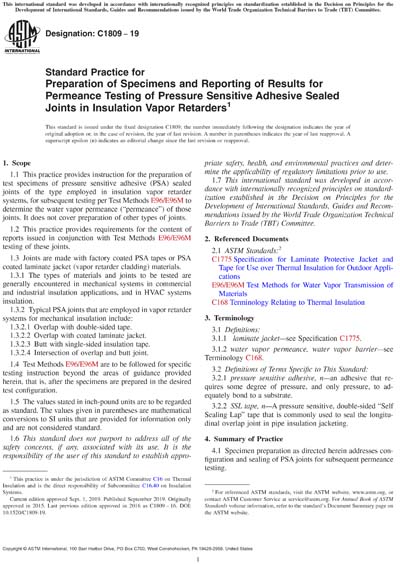Historical
ASTM C1809-19
Standard Practice for Preparation of Specimens and Reporting of Results for Permeance Testing of Pressure Sensitive Adhesive Sealed Joints in Insulation Vapor Retarders
1.1 This practice provides instruction for the preparation of test specimens of pressure sensitive adhesive (PSA) sealed joints of the type employed in insulation vapor retarder systems, for subsequent testing per Test Methods E96/E96M to determine the water vapor permeance (“permeance”) of those joints. It does not cover preparation of other types of joints.
1.2 This practice provides requirements for the content of reports issued in conjunction with Test Methods E96/E96M testing of these joints.
1.3 Joints are made with factory coated PSA tapes or PSA coated laminate jacket (vapor retarder cladding) materials.
1.3.1 The types of materials and joints to be tested are generally encountered in mechanical systems in commercial and industrial insulation applications, and in HVAC systems insulation.
1.3.2 Typical PSA joints that are employed in vapor retarder systems for mechanical insulation include:
1.3.2.1 Overlap with double-sided tape.
1.3.2.2 Overlap with coated laminate jacket.
1.3.2.3 Butt with single-sided insulation tape.
1.3.2.4 Intersection of overlap and butt joint.
1.4 Test Methods E96/E96M are to be followed for specific testing instruction beyond the areas of guidance provided herein, that is, after the specimens are prepared in the desired test configuration.
1.5 The values stated in inch-pound units are to be regarded as standard. The values given in parentheses are mathematical conversions to SI units that are provided for information only and are not considered standard.
1.6 This standard does not purport to address all of the safety concerns, if any, associated with its use. It is the responsibility of the user of this standard to establish appropriate safety, health, and environmental practices and determine the applicability of regulatory limitations prior to use.
1.7 This international standard was developed in accordance with internationally recognized principles on standardization established in the Decision on Principles for the Development of International Standards, Guides and Recommendations issued by the World Trade Organization Technical Barriers to Trade (TBT) Committee.
Content Provider
ASTM International [astm]






